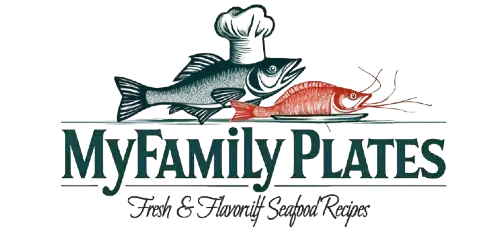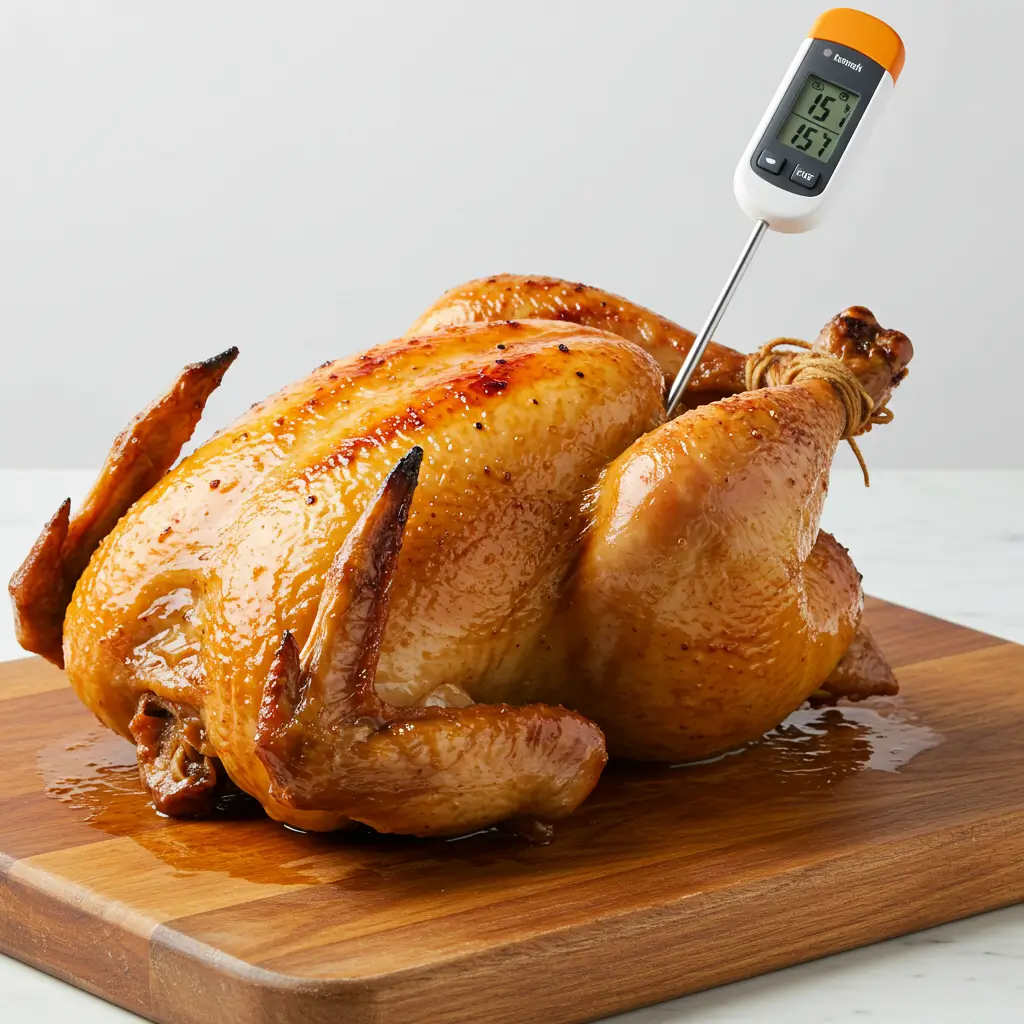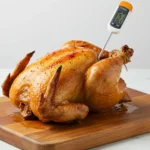Knowing the correct Chicken Internal Temperature—in both Fahrenheit and Celsius—is the secret to cooking chicken that’s not just safe to eat, but also moist and packed with flavor. Too often, home cooks either overcook chicken out of fear of food poisoning or undercook it, risking real health hazards. This guide walks you through the USDA-recommended safe chicken temperature, how it varies by cut, and pro-level cooking techniques to help you achieve perfectly juicy chicken every time—without the guesswork.
Looking for inspiration? Try our low-carb kung pao chicken recipe, or check out these creamy white chicken enchiladas, both cooked to perfection using internal temperature mastery.
Table of Contents
Table of Contents
What Temperature is Chicken Done?
Chicken is considered fully cooked and safe to eat when the internal temperature reaches 165°F (74°C) in the thickest part of the meat. This is the USDA-recommended temperature that guarantees harmful bacteria are destroyed.
- Chicken breasts: Pull them from the heat at 160°F (71°C) and let them rest for 5 minutes. Carryover cooking will bring them up to 165°F while keeping them juicy.
- Chicken thighs and drumsticks: These cuts taste best when cooked slightly higher, around 175°F (79°C), because the extra heat breaks down connective tissue and makes the meat more tender.
- Whole chicken: Check both the thickest part of the breast and the inner thigh to ensure both reach at least 165°F (74°C).
Rely on a meat thermometer for accuracy, not the color of the meat or the clarity of juices. This simple step ensures your chicken is both safe and delicious every time.
Safe Internal Temperature for Chicken (USDA)
According to the United States Department of Agriculture (USDA), the safe internal temperature for all chicken—including breasts, thighs, wings, and whole birds—is 165°F (74°C).
At this temperature:
- Harmful bacteria such as salmonella and campylobacter are destroyed.
- Chicken is safe to eat immediately, without the need for extended holding times.
- This guideline applies to all cooking methods—grilling, roasting, sautéing, air frying, or slow cooking.
For whole chickens, it’s important to check the temperature in two spots:
- The thickest part of the breast
- The inner thigh, avoiding the bone
Only when both areas read 165°F (74°C) can the chicken be considered fully safe.
By following the USDA recommendations, you can be confident your chicken is not only safe but also juicy and flavorful when cooked correctly.
What is the Safe Chicken Internal Temperature?
According to the USDA, chicken should be cooked to an internal temperature of 165°F (74°C) to ensure it is safe to eat. However, for cuts like thighs and drumsticks, many chefs recommend 175°F (79°C) or slightly higher to break down connective tissue and enhance tenderness. For best results, always insert a thermometer into the thickest part of the meat, avoiding bones, and let the chicken rest after cooking to account for carryover heat.
Why Chicken Internal Temperature Matters for Safe Cooking
How Undercooking Chicken Puts Your Health at Risk
Chicken is one of the most commonly consumed proteins in the United States, but it also comes with serious safety concerns if not cooked properly. Raw or undercooked chicken may contain harmful bacteria like salmonella or campylobacter, which are known to cause foodborne illnesses. The only reliable way to kill these bacteria is by cooking chicken to the correct internal temperature.
The USDA clearly recommends that chicken be cooked to an internal temperature of 165°F (74°C). This temperature ensures that any harmful microbes are destroyed, making the chicken safe to eat. It’s important to note that using color as a doneness indicator can be misleading—chicken may remain pink even when fully cooked, and juices running clear aren’t always a sign of safety.
Still not sure when it’s safe to serve? Use a meat thermometer to get an accurate reading instead of relying on guesswork.
Don’t miss our flavorful garlic parmesan chicken thighs — a great example of how using the right internal temperature turns everyday ingredients into something extraordinary.
Why Internal Temperature is Better Than Guesswork
Many home cooks, fearing food poisoning, overcook chicken just to be safe. While this avoids undercooking, it comes at the cost of flavor and texture. Overcooked chicken turns rubbery and dry, especially with lean cuts like chicken breasts.
By monitoring the internal temperature accurately, you can remove chicken from the heat at the right moment. This allows the meat to finish cooking through carryover heat, without drying out. It’s the best way to ensure food safety while keeping your chicken juicy and tender.
Cooking smart, not harder, is the secret. Whether you’re preparing a simple grilled breast or roasting a whole bird, temperature control is your most valuable tool.
Key Takeaways:
- Let the meat rest after cooking to benefit from carryover heat.
- Always use a thermometer—not guesswork or color—to check doneness.
- Target 165°F (74°C) for all poultry cuts.

Chicken Internal Temperature by Cut: Breast, Thighs, Wings & Whole Chicken
Different cuts of chicken cook at different rates—and they don’t all reach their best texture at the same temperature. Knowing the right internal temperature for each cut is the key to cooking chicken that’s both safe and delicious.
For example:
- Chicken breasts are lean and cook quickly. They should be pulled from the heat as soon as they hit 165°F (74°C) (or even 160°F/71°C, allowing for carryover cooking).
- Chicken thighs and drumsticks are fattier and contain more connective tissue. They’re safest at 165°F (74°C) but taste much better at 175°F (79°C) or slightly higher. The extra heat melts collagen, creating juicy, fall-apart tender meat.
- Whole chicken should be checked in two places—the thickest part of the breast and the inner thigh. Both need to reach at least 165°F (74°C). For best results, remove the bird from the oven at 160°F (71°C) and let it rest 5–10 minutes. Carryover heat will finish the job while keeping it juicy.
Chicken Internal Temp in Celsius (°C Conversion)
If your thermometer measures in Celsius, here’s the quick reference:
- Chicken breast: 74°C (165°F)
- Chicken thighs: 79°C (175°F)
- Whole chicken: 74°C (165°F)
Chicken Cooking Temperature Chart
| Chicken Cut | Safe Temp (°F) | Safe Temp (°C) | Notes |
|---|---|---|---|
| Chicken Breast | 165°F | 74°C | Remove at 160°F, rest to 165°F |
| Chicken Thighs | 175°F | 79°C | Dark meat benefits from higher heat |
| Whole Chicken | 165°F | 74°C | Check both breast & thigh |
| Chicken Wings | 165°F | 74°C | Same as breast |
Minimum Internal Temp for Chicken
The minimum safe internal temperature for chicken is 165°F (74°C) across all cuts.
- Going below this temperature risks harmful bacteria.
- Dark meat (like thighs and drumsticks) benefits from slightly higher temps—175–180°F (79–82°C)—for extra tenderness and flavor.
- The golden rule: never serve chicken under 165°F (74°C) unless using sous-vide with precise time and temperature control.
How to Control Chicken Internal Temperature for Juicy, Safe Results
How to Use a Meat Thermometer the Right Way
Mastering chicken internal temperature starts with the right tool: a reliable digital meat thermometer. While some home cooks still rely on the color of the meat or the clarity of the juices, these methods are inaccurate and unsafe. A thermometer takes the guesswork out of the process and ensures both safety and texture.
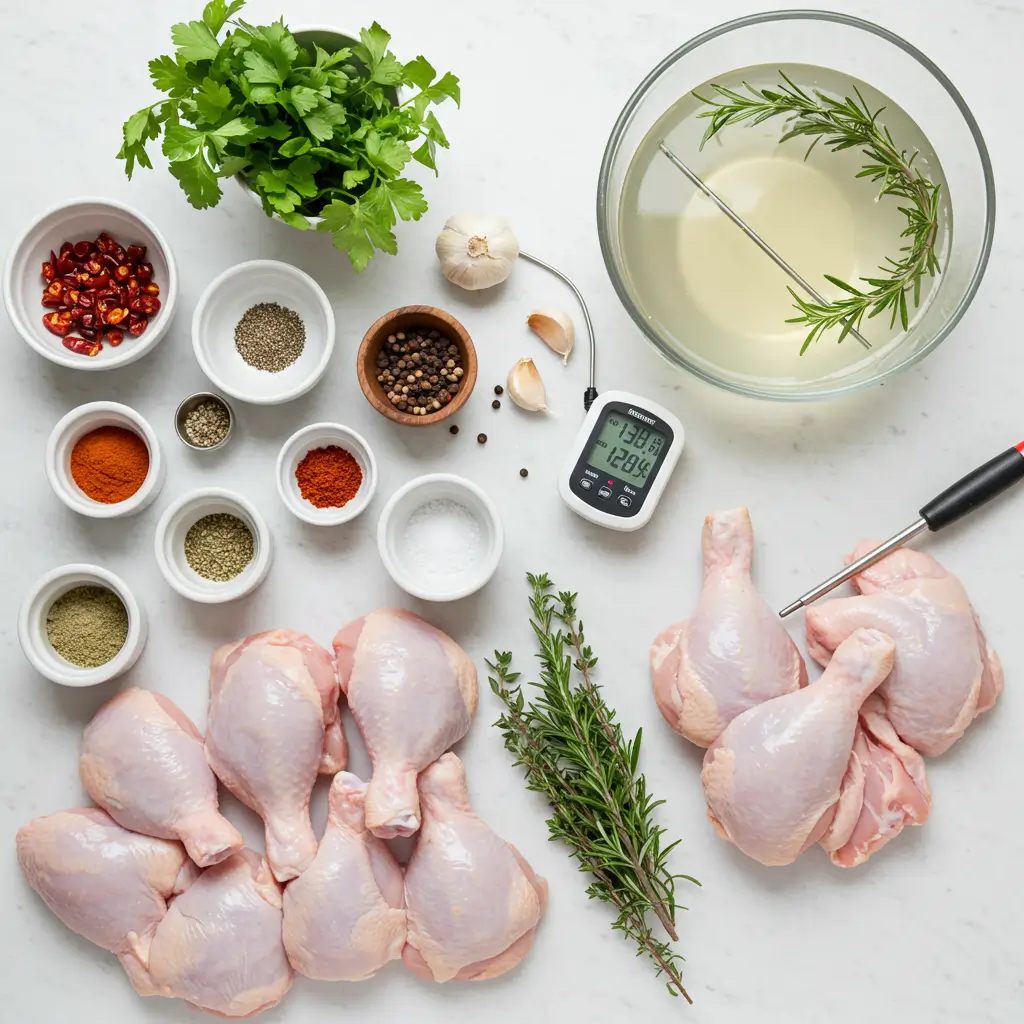
Here’s how to get it right every time:
- Insert the probe into the thickest part of the meat.
- Avoid touching bone, as it can produce a higher temperature reading.
- If cooking a whole chicken, test both the inner thigh and the breast.
- Watch the temperature carefully—the lowest stable number is what matters.
Example: When cooking chicken thighs, aim for 175°F (79°C). If you’re roasting a whole chicken, check the thigh for 165°F but let it rest to finish cooking safely and gently.
Using a thermometer ensures that dishes like our Neiman Marcus chicken casserole hit that perfect balance between tender and fully cooked—without drying out.
Carryover Cooking: Why Resting Is Just As Important as Cooking
Even after chicken leaves the heat source, it’s not done cooking. That’s the power of carryover cooking—the internal temperature continues to rise by 5–10 degrees as heat moves inward. If you don’t plan for this, you’re likely to overcook your chicken, especially lean cuts like breasts.
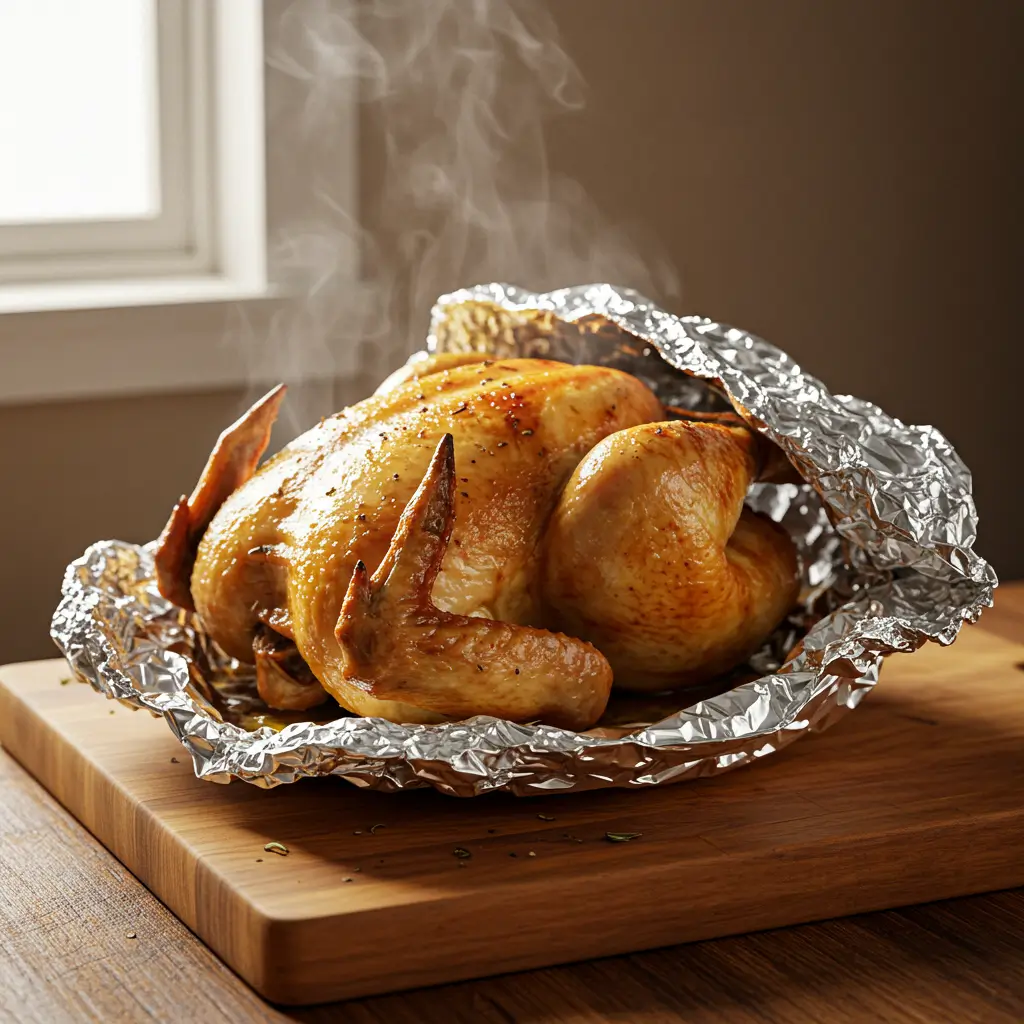
Here’s how to use carryover cooking to your advantage:
- Remove chicken from heat when it’s 5°F below the target temp.
- For whole chickens, pull at 160°F, and let it rise to 165°F during resting.
- Always let your chicken rest for at least 5 minutes before slicing.
Resting also redistributes juices throughout the meat, so you don’t lose moisture on the cutting board. This simple step makes a huge difference in dishes like our spicy gochujang chicken bowls, where flavor and texture are everything.
Pro tip: Tent your chicken with foil during the resting period to retain heat without overcooking.
Why Thermometer Placement Affects Accuracy
Thermometer accuracy depends on where you place it:
- For boneless breasts, go dead-center into the thickest part.
- For bone-in thighs, aim for the meat closest to the center, avoiding the bone.
- For stuffed or whole chickens, test both the breast and thigh areas individually.
Getting the right chicken internal temperature isn’t just about tools—it’s about technique.
Quick Recap:
- Know your target temps: 165°F for breasts, 175°F for thighs.
- Always use a digital thermometer—not color—to judge doneness.
- Allow carryover cooking by removing chicken early and letting it rest.\
Pro Tips to Master Chicken Internal Temperature for Flavor
Avoid Overcooking Chicken: Don’t Fall for the 170°F Myth
One of the biggest mistakes home cooks make is believing that all chicken must be cooked to 170°F or higher to be safe. While this may feel “safer,” it often leads to dry, chewy meat—especially with chicken breasts.
Here’s the truth:
- Chicken breasts are fully safe at 165°F (74°C). Going beyond this temperature causes moisture loss.
- Thighs and drumsticks, on the other hand, actually benefit from slightly higher temps—about 175°F to 180°F (79–82°C). The extra heat melts down collagen and connective tissue, turning dark meat into juicy, fall-apart deliciousness.
If you’re cooking a variety of cuts at once, consider separating them during cooking or removing different parts at different times. This technique is a game-changer when you’re preparing meals like our creamy white chicken enchiladas, which combine white and dark meat for texture contrast.
Looking for inspiration? Try our chicken Caesar salad sandwiches — the perfect way to showcase juicy, correctly cooked chicken breasts.
Best Practices for Flavorful, Moist Chicken
Temperature alone doesn’t guarantee delicious chicken. It needs to work hand-in-hand with techniques that enhance flavor and texture. Follow these chef-level strategies:
1. Brining
Soaking chicken in a saltwater solution before cooking helps retain moisture and enhances seasoning from the inside out. Just 30 minutes of brining can make a noticeable difference.
2. Marinating
Add flavor and tenderness with acidic marinades. Ingredients like lemon juice, yogurt, buttermilk, or vinegar help break down proteins and infuse bold flavor.
3. Searing or High-Heat Roasting
Start with a high-temperature sear or roast to lock in juices, then reduce the heat to finish cooking evenly. This dual-technique method preserves tenderness while building rich, golden crusts.
4. Rest Before Slicing
Cutting into chicken right after cooking releases all those delicious juices onto the plate. Always let chicken rest for 5–10 minutes so juices redistribute into the meat.
These techniques, when paired with precise chicken internal temperature, transform even basic dishes into memorable meals. Try it out in our low-carb kung pao chicken, where timing and texture go hand-in-hand.
Quick Tips Recap:
- Stop cooking white meat at 165°F—no higher.
- Cook thighs and legs up to 175°F for better texture.
- Use brining, marinating, and carryover cooking for flavor and tenderness.
FAQs About Chicken Internal Temperature
Is chicken safe to eat at 145°F internal temperature?
Technically, yes—but only if it’s held at that temperature for a long enough time. According to USDA time-temperature tables, chicken held at 145°F (63°C) for at least 9–10 minutes can be considered safe to eat. However, this method requires precise timing and isn’t practical for most home cooks. The safest bet? Cook chicken to 165°F (74°C) to kill bacteria quickly and safely.
Is chicken done at 165 or 180?
Chicken is fully cooked and safe at 165°F (74°C) across all cuts. However, dark meat such as thighs and drumsticks often benefits from higher temps—up to 180°F (82°C). This higher heat breaks down connective tissue, resulting in more flavorful, tender meat. Chicken breasts, on the other hand, are best when pulled at 160–165°F to avoid dryness.
Is chicken overcooked at 170 degrees?
It depends on the cut:
For chicken breasts, yes—170°F is likely overcooked, leading to dry, tough meat.
For thighs and legs, 170–175°F is actually ideal, as it creates a richer, more tender texture by breaking down collagen.
So, while 170°F is too high for lean white meat, it’s great for dark cuts.
When should I take out chicken so it reaches 165°F?
To get juicy chicken, remove it from the heat when the internal temperature hits about 160°F (71°C). Let it rest for 5–10 minutes. During this time, carryover cooking will raise the temperature to 165°F, locking in juices while keeping the meat safe.
What internal temperature should chicken be cooked to?
All chicken cuts should reach a minimum internal temperature of 165°F (74°C) to be considered safe. Use a food thermometer to measure the temperature in the thickest part of the meat, avoiding any bones.
What is the safe internal temperature for chicken?
According to the USDA, the safe internal temperature for all chicken—including whole birds, breasts, thighs, wings, and ground poultry—is 165°F (74°C). This temperature ensures the elimination of pathogens like salmonella, making your chicken both safe and delicious.
Why is my chicken still pink at 165°F?
Color isn’t a reliable indicator of doneness. Even if your chicken is pink, it can still be safe if it reaches 165°F (74°C) internally. The presence of bone marrow, young chicken, or certain cooking methods can all cause pink hues in cooked meat.
Is chicken cooked at 70°C?
Yes, chicken cooked to 70°C (158°F) is nearly safe, but it depends on how long it’s held at that temperature. According to food safety guidelines, chicken needs to be held at 70°C for at least 2–3 minutes to effectively kill harmful bacteria. To avoid any risk, the USDA still recommends cooking to 74°C (165°F), which ensures immediate bacterial elimination.
Is chicken safe to eat at 65°C?
Chicken at 65°C (149°F) is not instantly safe unless it’s held at that temperature for about 15–20 minutes to kill bacteria. While this technique can work in professional settings (e.g., sous-vide), it’s not ideal for everyday cooking. For safe and reliable results, always cook chicken to 74°C (165°F) in the thickest part of the meat.
Conclusion
Cooking chicken properly isn’t just about avoiding illness—it’s about getting the best possible flavor and texture in every bite. By understanding and using the correct chicken internal temperature, you can cook with confidence, knowing your meals are safe, juicy, and flavorful every time.
Whether you’re roasting a whole bird, grilling thighs, or sautéing breasts, a meat thermometer should be your most trusted kitchen tool. When used correctly, it takes the guesswork out of cooking and puts precision—and great taste—back on your plate.
From choosing the right cut to applying techniques like brining, carryover cooking, and accurate thermometer placement, these small steps create a huge impact on the final dish.
Looking for your next perfect chicken recipe?
Don’t miss our garlic parmesan chicken thighs, kung pao chicken, or Neiman Marcus casserole—all cooked to the perfect internal temperature and loaded with flavor.
Bookmark this guide, share it with your favorite home chef, and keep our temperature chart close. With these tips, you’ll never serve dry or undercooked chicken again.
PrintChicken Internal Temperature Guide for Perfectly Cooked Poultry
Learn how to achieve the perfect Chicken Internal Temperature for juicy, safe poultry every time. This guide covers the best temperatures for breasts, thighs, wings, and whole chicken, plus expert tips.
- Prep Time: 10 minutes
- Cook Time: 30 minutes
- Total Time: 40 minutes
- Yield: 4 servings
- Category: Guide
- Method: Roasting/Grilling
- Cuisine: American
Ingredients
Whole chicken or chicken cuts
Digital food thermometer
Salt and pepper
Optional: marinades or brines for added flavor
Instructions
1. Preheat your oven or grill to the appropriate setting.
2. Insert a food thermometer into the thickest part of the chicken (avoid bones).
3. Cook until the Chicken Internal Temperature reaches 160°F (71°C), then remove from heat.
4. Allow chicken to rest for 5–10 minutes; carryover heat will bring it to 165°F (74°C).
5. Serve and enjoy perfectly cooked chicken every time.
Notes
Dark meat like thighs should be cooked to 175°F (79°C) for optimal tenderness.
Always rest your chicken to allow juices to redistribute.
Use the chicken temperature chart to adjust cooking for each cut.
Let’s Stay Connected: Love recipes like these Chicken Internal Temperature Guide ? Follow us on Pinterest for daily inspiration, catch full video walkthroughs on YouTube, and join the flavor-loving community on Facebook. For more delicious meals, visit MyFamilyPlates and browse all our recipes.
